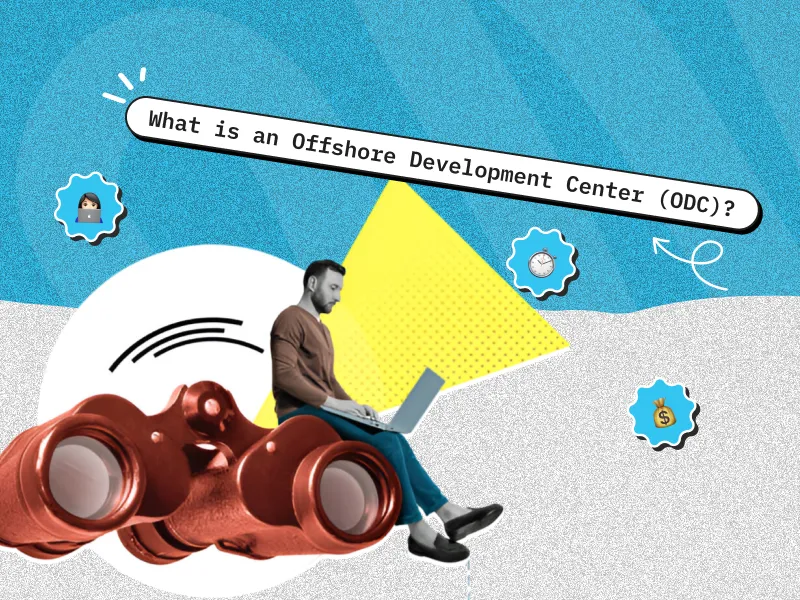Quick Summary:
An Offshore Development Center (ODC) is a dedicated remote team that provides businesses with cost-effective, scalable, and high-quality software development. It operates as an extension of a company, offering services like software development, QA, and support. Key benefits include reduced operational costs, access to global talent, and faster time-to-market. ODCs follow strict security measures and are commonly used by startups and enterprises to scale operations efficiently. Partnering with a reliable ODC ensures seamless collaboration, innovation, and business growth.
Introduction
As businesses strive to stay competitive in an increasingly digital world, many are turning to Offshore Development Centers (ODCs) as a strategic solution. An ODC allows companies to establish a dedicated team of skilled professionals in an offshore location, helping them reduce costs, access global talent, and accelerate development cycles.
With rapid globalization and advancements in remote collaboration tools, the ODC model has gained significant popularity across industries. But what exactly is an ODC, and how can your business benefit from one? This article provides an in-depth look at ODCs, their advantages, operational models, and a step-by-step guide to setting up an offshore development center.
What is an ODC?
An Offshore Development Center (ODC) is a dedicated remote team of developers, designers, project managers, and other IT professionals set up in a foreign country to handle software development and IT-related tasks. Unlike traditional outsourcing, an ODC functions as an extension of the parent company, offering greater control over processes, security, and project execution.
How Does an ODC Function?
An ODC operates as a self-sufficient unit, handling tasks such as software development, testing, maintenance, and IT support. The team works exclusively for the parent company, ensuring seamless collaboration, confidentiality, and alignment with business goals.
Read More: Top 10 Offshore Software Development Companies in 2025
Advantages and Benefits of Establishing an Offshore Development Center (ODC)
Setting up an Offshore Development Center (ODC) brings numerous advantages for businesses looking to scale their software development capabilities while optimizing costs. Below are the key benefits of establishing an ODC:
1. Cost Savings and Efficiency
Setting up an ODC in countries with lower labor costs helps businesses save significantly on salaries, infrastructure, and operational expenses.
2. Access to a Global Talent Pool
An ODC enables companies to tap into skilled professionals across different time zones, ensuring access to top-tier talent that may not be available locally.
3. Scalability and Flexibility
ODCs allow businesses to quickly scale their development teams based on project requirements, ensuring agility in dynamic market conditions.
4. Improved Focus on Core Business Operations
By delegating software development tasks to an ODC, businesses can focus on strategic initiatives and core competencies without getting overwhelmed by operational complexities.
5. Enhanced Productivity and Faster Time-to-Market
With dedicated teams working round the clock, ODCs accelerate development cycles, leading to quicker product launches and improved market competitiveness.
Models of ODCs
Businesses can choose from different Offshore Development Center (ODC) models based on their operational needs, budget, and level of control they want to maintain. Below are the four primary ODC models:
1. Captive ODC Model
In the Captive ODC model, a company fully owns and manages its offshore development center. This means:
✅ Complete control over operations, security, and processes.
✅ Direct hiring and management of offshore employees.
✅ Full ownership of intellectual property (IP) and data security.
🔹 Best suited for:
- Large enterprises with long-term offshore development needs.
- Companies handling sensitive data that require strict security compliance.
- Organizations looking for cost efficiency in the long run.
Example: Tech giants like Microsoft and Google operate captive ODCs in locations like India and Eastern Europe to leverage skilled talent while maintaining full control over their operations.
2. Build-Operate-Transfer (BOT) Model
The BOT model involves three phases:
1️⃣ Build – An offshore partner sets up the ODC, including infrastructure, hiring, and legal formalities.
2️⃣ Operate – The offshore provider manages the center for a specified period, ensuring smooth project execution.
3️⃣ Transfer – The full ownership of the ODC is transferred to the client after a defined period.
✅ Minimizes initial setup risks and investment.
✅ Offers a gradual transition to full ownership.
✅ Reduces administrative burdens while setting up operations.
🔹 Best suited for:
- Businesses want to test the waters before fully committing.
- Companies that lack the expertise to set up an offshore center independently.
- Organizations planning for long-term offshore expansion.
Example: A U.S.-based SaaS company might partner with an offshore firm in Vietnam to establish an ODC under the BOT model. After 2–3 years of successful operation, the company takes full ownership and integrates it into its main business.
3. Fully Managed ODC Model
In this model, a third-party provider handles all aspects of the offshore development center, including:
✅ Recruitment and team management
✅ Infrastructure setup and IT support
✅ Project execution, workflow management, and quality control
The client company simply provides project requirements and oversees the final deliverables, while the offshore provider ensures smooth execution.
🔹 Best suited for:
- Startups and SMEs that lack in-house resources for offshore team management.
- Businesses that prefer a hassle-free outsourcing experience.
- Companies focused on speed-to-market and cost-efficiency.
Example: A fintech startup in the U.K. might hire a fully managed ODC in India to handle software development, allowing them to focus on business growth.
4. Hybrid ODC Model
A Hybrid ODC model blends elements of the Captive and Fully Managed models, allowing businesses to:
✅ Retain core operations in-house while outsourcing specific tasks.
✅ Maintain partial control over recruitment, project management, and workflows.
✅ Leverage an offshore partner for infrastructure setup, administrative support, and non-core functions.
🔹 Best suited for:
- Businesses that want both control and flexibility.
- Companies looking to scale operations while keeping key processes in-house.
- Organizations experimenting with offshore development before committing to full ownership.
Example: A U.S.-based healthcare company may keep its core AI-driven analytics team in-house but set up a Hybrid ODC in Eastern Europe to handle frontend and backend development.
Choosing the Right ODC Model
Each ODC model serves a different business need:
- Captive ODC → Best for large enterprises seeking full control.
- BOT Model → Ideal for mid-to-large businesses looking for a gradual transition.
- Fully Managed ODC → Perfect for startups and SMEs needing an end-to-end solution.
- Hybrid ODC → A good fit for companies needing flexibility in managing offshore operations.
When to Consider Offshore Software Development Center Services
Setting up an Offshore Development Center (ODC) is a strategic decision that depends on various business needs. Below are key business scenarios and industries where ODCs make the most sense.
Business Scenarios Where ODCs Are the Best Fit
1. Rapid Business Expansion & Need for Scalability
If your company is growing fast and struggling to scale development teams, an ODC provides access to a larger talent pool without the overhead of local hiring. Offshore teams can be quickly expanded or reduced based on project demands.
For example, a fast-growing fintech startup needs to scale its development team for a new mobile app launch but lacks local talent availability. An ODC in India can provide skilled developers quickly.
2. Shortage of Skilled Talent in the Local Market
Certain tech skills, such as AI, blockchain, and DevOps, may be scarce or expensive in your home country. An ODC gives you access to specialized expertise without paying premium local salaries.
For instance, a U.S. SaaS company wants to build an AI-powered chatbot but faces a talent shortage in machine learning engineers. Setting up an ODC in Eastern Europe provides access to a skilled workforce at a lower cost.
3. High Development and Operational Costs
Hiring local developers, leasing office space, and maintaining infrastructure in high-cost regions can strain budgets. ODCs help reduce development costs while maintaining quality standards.
A startup in San Francisco with limited funding sets up an ODC in Vietnam to cut software development costs by 50 percent while still delivering high-quality products.
4. Requirement for Round-the-Clock Development
Businesses needing 24/7 development and support can leverage time zone differences to keep projects running continuously. ODCs in different time zones ensure faster turnaround times.
For example, a European eCommerce company sets up an ODC in India to provide overnight software maintenance and customer support, ensuring smooth operations.
5. Need for Specialized Technology Expertise
If a company needs niche tech skills like cybersecurity, blockchain, or AI, an ODC can provide a dedicated team of experts. Many offshore locations have strong tech ecosystems and experienced professionals in cutting-edge technologies.
For example, a healthtech company in Germany wants to develop a blockchain-based patient record system but lacks in-house expertise. They establish an ODC in Ukraine, known for blockchain development.
6. Desire for Faster Project Turnaround Time
Offshore teams allow businesses to speed up development by running multiple projects simultaneously. Agile and DevOps methodologies help reduce time-to-market.
For instance, a gaming company in the U.S. wants to launch a new multiplayer game within six months. By outsourcing development to an ODC in Poland, they cut development time by 40 percent.
Industries That Leverage ODCs for Growth
1. SaaS & Software Development – ODCs help build and maintain cloud-based software solutions at scale.
2. Fintech & Banking – Offshore teams develop secure financial applications, payment gateways, and fraud detection systems.
3. eCommerce & Retail – Companies leverage ODCs for web and app development, AI-driven personalization, and backend support.
4. Healthcare & MedTech – Offshore developers build telemedicine platforms, AI-powered diagnostics, and medical data systems.
5. Gaming & AR/VR – ODCs help in game design, UI/UX development, and VR simulations.
6. AI & Machine Learning – Companies rely on ODCs to develop AI models, NLP applications, and automation solutions.
Read More: Why India is the Top Choice for Offshore Development Center
Setting Up an Offshore Development Center (ODC)
Establishing an Offshore Development Center (ODC) requires careful planning to ensure long-term success. The process involves choosing the right location, selecting the appropriate model, and setting up infrastructure and workflows.
Choosing the Right Location for Your ODC Service
The location of your ODC plays a crucial role in cost-effectiveness, talent availability, legal compliance, and operational efficiency. Here are the key factors to consider when selecting an offshore development destination:
Key Factors to Consider
- Cost of Operations – Compare salaries, office rent, taxes, and overall business expenses in different countries.
- Talent Availability – Ensure the region has skilled professionals in the required technologies.
- Infrastructure & Connectivity – Reliable internet, IT parks, and strong transportation networks are essential.
- Legal & Compliance Framework – Check the country’s intellectual property laws, data protection policies, and government regulations.
- Time Zone Difference – Choose a region that allows convenient collaboration with your headquarters.
- Political & Economic Stability – A stable business environment ensures smooth operations.
- Cultural & Language Compatibility – Minimize communication barriers by selecting a location with English-speaking professionals.
Top Offshore Development Destinations
- India – Large IT talent pool, cost-effective, strong English proficiency.
- Ukraine – Skilled developers, strong expertise in AI and blockchain.
- Poland – Excellent IT education, EU business regulations.
- Vietnam – Emerging tech hub, cost-effective workforce.
- Philippines – Strong English-speaking developers, BPO expertise.
- Mexico – Nearshore option for U.S. companies, cultural alignment.
Steps Involved in Establishing an ODC
Setting up an ODC involves several steps, from defining project goals to hiring the right team and ensuring smooth operations.
Step 1: Define Project Requirements and Goals
- Identify the type of projects the ODC will handle (e.g., web development, AI, DevOps).
- Set clear objectives, expected outcomes, and key performance indicators (KPIs).
Step 2: Choose the Right ODC Model
Select an operational model that aligns with your business strategy:
- Captive ODC – Full control, requires high initial investment.
- Build-Operate-Transfer (BOT) – Outsourced setup, later transferred to the client.
- Fully Managed ODC – Third-party manages everything.
- Hybrid ODC – Combines captive and managed approaches.
Step 3: Select a Reliable Offshore Partner
- Evaluate the experience, reputation, and expertise of offshore vendors.
- Check client testimonials, case studies, and security compliance.
- Conduct pilot projects to assess performance.
Step 4: Set Up Infrastructure and Technology
- Establish office space, networking, and hardware in the offshore location.
- Implement cloud platforms, development environments, and security tools to ensure smooth remote operations.
Step 5: Recruit and Onboard Skilled Professionals
- Hire developers, project managers, testers, and DevOps engineers based on project needs.
- Ensure alignment with company culture and development methodologies.
Step 6: Establish Workflows and Security Protocols
- Define agile development workflows (Scrum, Kanban, etc.).
- Set up data security measures like VPNs, encryption, and access control policies.
- Use collaboration tools (Slack, Jira, GitHub) for seamless communication.
Step 7: Monitor Performance and Optimize Operations
- Track KPIs such as project deadlines, code quality, and team productivity.
- Conduct regular performance reviews to improve efficiency.
- Optimize processes based on feedback and technological advancements.
Best Practices for Operating an Offshore Development Center (ODC)
Successfully managing an ODC requires strategic planning, efficient collaboration, and strong security measures. Here are the best practices to ensure smooth operations:
Managing Cultural and Communication Barriers
- Cultural Sensitivity Training – Educate both onshore and offshore teams about cultural differences to foster better teamwork.
- Clear Communication Guidelines – Standardize communication channels and protocols to avoid misunderstandings.
- Regular Check-ins & Feedback Loops – Schedule frequent virtual meetings to keep everyone aligned.
Techniques for Effective Remote Team Collaboration
- Agile & DevOps Integration – Implement agile methodologies for flexibility and DevOps practices for faster delivery.
- Collaboration Tools – Use platforms like Slack, Microsoft Teams, Jira, and Trello for seamless workflow management.
- Time Zone Optimization – Establish overlapping working hours for better real-time collaboration.
Security & Compliance Best Practices
- Data Protection Measures – Enforce strict access controls, VPN usage, and encrypted data transfers.
- Legal Agreements – Ensure NDAs and IP protection agreements are in place to safeguard business interests.
- Regular Audits – Conduct periodic security and performance audits to identify and resolve vulnerabilities.
Comparing ODCs to Traditional Outsourcing
While both Offshore Development Centers (ODCs) and traditional outsourcing involve leveraging external talent, they differ significantly in control, cost, and long-term benefits.
Key Differences Between ODCs and Traditional Outsourcing
| Factor | Offshore Development Center (ODC) | Traditional Outsourcing |
| Control | Full control over team, processes, and IP | Limited control, managed by third-party vendor |
| Scalability | Easily scalable as a dedicated team is in place | Scaling may require contract renegotiations |
| Cost Efficiency | Higher initial investment but lower long-term costs | Lower initial cost but higher recurring expenses |
| Security & IP Protection | Stronger security as the team works exclusively for your company | Greater risk as multiple clients share resources |
| Team Integration | Long-term alignment with company culture and goals | Short-term engagement with limited integration |
Read More: Offshore Development Center vs. Outsourcing
Deciding Between an ODC and Traditional Outsourcing
- Choose an ODC if you need long-term, dedicated teams, full control, and better security.
- Choose traditional outsourcing for short-term projects, quick cost savings, and less operational involvement.
Conclusion:
Setting up an Offshore Development Center (ODC) is a strategic move for businesses looking to scale efficiently, reduce costs, and access top-tier global talent. Whether you choose a Captive, BOT, Fully Managed, or Hybrid ODC model, the right approach depends on your business goals, budget, and level of control required.
At Creole Studios, we specialize in setting up and managing Offshore Development Centers tailored to your unique business needs. With our experienced team, robust infrastructure, and seamless execution, we help companies drive innovation, accelerate development cycles, and gain a competitive edge.Want to explore how an ODC can benefit your business? Book a free 30-minute consultation with our experts today and take the first step toward building a successful offshore development team!











 30 mins free Consulting
30 mins free Consulting 
 7 min read
7 min read 







 Love we get from the world
Love we get from the world 